- Home
- About
- Map
- Trips
- Bringing Boat West
- Migration West
- Solo Motorcycle Ride
- Final Family XC Trip
- Colorado Rockies
- Graduates' XC Trip
- Yosemite & Nevada
- Colorado & Utah
- Best of Utah
- Southern Loop
- Pacific Northwest
- Northern Loop
- Los Angeles to NYC
- East Coast Trips
- Martha's Vineyard
- 1 Week in Quebec
- Southeast Coast
- NH Backpacking
- Martha's Vineyard
- Canadian Maritimes
- Ocracoke Island
- Edisto Island
- First Landing '02
- Hunting Island '02
- Stowe in Winter
- Hunting Island '01
- Lake Placid
- Chesapeake
- Provincetown
- Hunting Island '00
- Acadia in Winter
- Boston Suburbs
- Niagara Falls
- First Landing '99
- Cape Hatteras
- West Coast Trips
- Burning Man
- Utah Off-Roading
- Maui
- Mojave 4WD Course
- Colorado River Rafting
- Bishop & Death Valley
- Kauai
- Yosemite Fall
- Utah Off-Road
- Lost Coast
- Yosemite Valley
- Arizona and New Mexico
- Pescadero & Capitola
- Bishop & Death Valley
- San Diego, Anza Borrego, Joshua Tree
- Carmel
- Death Valley in Fall
- Yosemite in the Fall
- Pacific Northwest
- Utah Off-Roading
- Southern CA Deserts
- Yosemite & Covid
- Lake Powell Covid
- Eastern Sierra & Covid
- Bishop & Death Valley
- Central & SE Oregon
- Mojave Road
- Eastern Sierra
- Trinity Alps
- Tuolumne Meadows
- Lake Powell Boating
- Eastern Sierra
- Yosemite Winter
- Hawaii
- 4WD Eastern Sierra
- 4WD Death Valley +
- Southern CA Deserts
- Christmas in Tahoe
- Yosemite & Pinnacles
- Totality
- Yosemite & Sierra
- Yosemite Christmas
- Yosemite, San Diego
- Yosemite & North CA
- Seattle to Sierra
- Southwest Deserts
- Yosemite & Sierra
- Pacific Northwest
- Yosemite & South CA
- Pacific Northwest
- Northern California
- Southern Alaska
- Vancouver Island
- International Trips
- Index
- Tips
- Books
- Photos/Videos
- Search
- Contact
Gros Morne National Park (Shallow Bay), NFL
Wednesday, July 21, 2004 - 9:00am by Lolo
41 miles and 1 hour from our last stop - 2 night stay
Travelogue
Shallow Bay and the Western Brook Pond Boat Tour were the only things besides the Newfoundland Ferry that caused me to stray from my recently acquired, care-free, “wing it” style of travel. Everything I had read about Gros Morne raved about this boat tour and called it the single must-see in the park. So, about a month before our departure, I called the Ocean View Motel in Rocky Harbour (709-458-2730) and reserved our boat tour. I then called Parcs Canada and reserved 2 nights at the nearby Shallow Bay Campground, also described as one of the best in the park. Perhaps I was a bit paranoid, but I had no intentions of coming all the way to Newfoundland and missing out on the highlights.
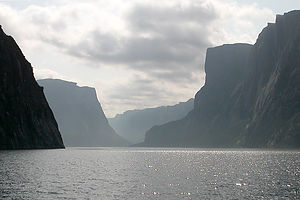 Western Brook Pond FjordI just hoped that the weather improved. The brief bit of sunshine we had seen that morning had now been replaced by the usual fog and mist. Gros Morne, which is French for “big gloomy” was certainly living up to its name and was beginning to make us a bit gloomy.
Western Brook Pond FjordI just hoped that the weather improved. The brief bit of sunshine we had seen that morning had now been replaced by the usual fog and mist. Gros Morne, which is French for “big gloomy” was certainly living up to its name and was beginning to make us a bit gloomy.
As we headed north out of Rocky Harbour on the Viking Trail, the topography began to change. Unlike the hillier sections further south, we were now crossing a broad coastal plain covered with bogs and tuckamore. The road ran right alongside the coastline, with great views of the Gulf of St. Lawrence to our left and the snow-capped Long Range Mountains off in the distance to our right. I thought the southern section of the park was pretty undeveloped, but this section of the park was even more remote and pristine. Other than the tiny fishing villages of Sally’s Cove and St. Paul’s, there was no other sign of civilization in this whole 40 mile stretch.
We stopped for lunch at the Broom Point picnic area, where the Western Brook Pond flows into the Gulf of St. Lawrence. After lunch, we walked down a wooden staircase to the left of the pond (which at this point was really a river), out onto a sand spit, with the ocean on one side and the river on the other—a very nice spot to beach and fish if the weather ever improved. We met a local fisherman who told us that the trout fishing at the mouth of the river was very good, especially when the tide was flowing out, and that if we stayed to the ocean side of the sign which he pointed to, we wouldn’t need a fishing permit. Only on Newfoundland do you meet a fisherman willing to give away fishing secrets.
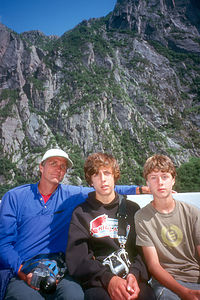 Herb and boys on boat cruiseFrom Broom Point, we continued north on the Viking Trail, exiting at the village of Cow Head to get to our campground in Shallow Bay. After the cutesy names that Nova Scotia gives to everything to attract tourists, I found the name Cow Head quite refreshing. Surprisingly though, despite its name and remoteness, this small village serves as the cultural center for the Western Region of Newfoundland. It is home to the Gros Morne Theater Festival, which presents a series of 8 different plays throughout the summer, and to the Dr. Henry N. Payne Community Museum, the longest running museum on the west coast of Newfoundland.
Herb and boys on boat cruiseFrom Broom Point, we continued north on the Viking Trail, exiting at the village of Cow Head to get to our campground in Shallow Bay. After the cutesy names that Nova Scotia gives to everything to attract tourists, I found the name Cow Head quite refreshing. Surprisingly though, despite its name and remoteness, this small village serves as the cultural center for the Western Region of Newfoundland. It is home to the Gros Morne Theater Festival, which presents a series of 8 different plays throughout the summer, and to the Dr. Henry N. Payne Community Museum, the longest running museum on the west coast of Newfoundland.
We drove through the village and reentered the park on a dead-end road that led into the Shallow Bay Campground. The guide books were right. It was located on a beautiful 3-mile sandy beach, complete with surf, and had miles of hiking and biking trails throughout its forest. Unfortunately, rather than directly on the beach, the campground was situated behind a line of protective tuckamore bushes. Although the bushes blocked the view, I’m sure they came in handy during a storm. Our site was just a short distance from the path that led through the tuckamore to the beach.
The weather wasn’t very conducive to beaching, so instead, we hopped on our bikes and headed into the village of Cow Head in search of culture or the ingredients for s’mores—whichever we could find first. Culture came first in the form of the Dr. Henry N. Payne Community Museum, housed in what looked like a modest fishing shack. We paid our $2 per person admission fee to the nice young tour guide, who was a local high school student. I had a feeling we were the first customers she had seen that day, or perhaps even that week. She led us through the small rooms of the house proudly showing us its treasures. Besides the furnishings and household objects depicting the early life in a small fishing outpost, there was a rather eclectic mix of artifacts, ranging from an ax used as a murder weapon over 200 years ago to a 700 year old walrus skull. At one point, the tour guide left us alone for a moment and then returned wearing a pair of latex gloves and holding a post card. The post card was of the Titanic and it was sent to Dr. Payne from one of its unfortunate passengers. I think she must have really liked us because I got the impression that she didn’t show this to just anyone. After chatting with her some more, we learned that the following year she was going off to college in St. John’s at the very opposite end of the island, a very big change from life in Cow Head and one that she was greatly looking forward to. I might have come into the museum a bit skeptically, but I really liked it and I do think I left it with a much better sense for what life was like in Cow Head, both in Dr. Payne’s time and now.
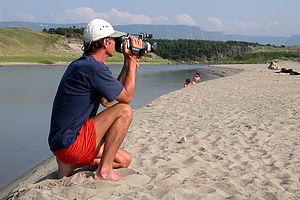 Herb videotaping at Broom PointFinding the s’more stuff was a bit more difficult. I don’t know where these people food shop. The first little grocery store we stopped in had no marshmallows, but the woman behind the counter was kind enough to direct us to the package store down the street, where she thought we might have more luck. She was right. This was a very different world from suburban New Jersey—not necessarily better or worse, just different. I think it’s a great experience for the kids (and me) to see that there’s not just one right way to live, and that they have more in common than they would have thought with people from some very different places than their own home town. That’s something that you can only get from traveling.
Herb videotaping at Broom PointFinding the s’more stuff was a bit more difficult. I don’t know where these people food shop. The first little grocery store we stopped in had no marshmallows, but the woman behind the counter was kind enough to direct us to the package store down the street, where she thought we might have more luck. She was right. This was a very different world from suburban New Jersey—not necessarily better or worse, just different. I think it’s a great experience for the kids (and me) to see that there’s not just one right way to live, and that they have more in common than they would have thought with people from some very different places than their own home town. That’s something that you can only get from traveling.
The next morning we awoke to the all too familiar sound of rain hitting the roof of our motorhome—and this was the day of our highly anticipated boat trip up Western Brook Pond. Since seeing it in the rain was better than not seeing it at all, we drove down to the Western Brook Pond parking lot and packed our rain gear for the 45-minute hike to the boat dock. Just as we were about to lock the RV and start walking, it happened—the sun came out. I couldn’t believe it! Everything looked different. We put our rain jackets back in the RV and started for the boat. The hike was an easy one, along a boardwalk over bogs with snow-capped mountains in the distance—very pretty and worth doing even without the boat trip at the end. There were lots of other people on the trail, which made me begin to wonder just how crowded this boat was going to be. Along the way, a crowd began to form around a gentleman with binoculars, who had spotted a moose off in the distance. Apparently, they are quite common in this area—moose that is, not men with binoculars.
When we reached the boat dock, we paid for our reserved tickets and joined the large crowd beginning to gather near the dock. There were an awful lot of people here to cram on the two tour boats we saw. As 10 a.m. approached, we and our fellow tourists began subtly jockeying for a good boarding position. I didn’t realize then just how important that would be. The prime seats were on the upper deck where there was an unobstructed 360 degree panoramic view. Of course, that’s where the people in the front of the line made a beeline too. We boarded just after the last seat on the upper deck was taken forcing us to quickly scramble for a less desirable seat at the back of the lower deck. From here, the view was somewhat obstructed and we got to see where we had been rather than where we were heading. They really packed us in pretty tightly.
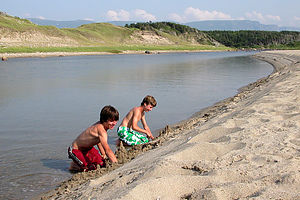 Boy's building sand castles at Broom PointThe pond, however, which was really a landlocked fjord and not a pond at all, was absolutely stunning, with waters so dark and deep that the temperature barely rose above freezing. As our boat set off from the dock, it appeared to be heading right towards a sheer rock wall, almost a half a mile high. Undaunted, our trusty little boat found the opening through the cliffs and continued up the ever-narrowing tail of the pond, sandwiched between giant cliffs with hanging gardens and cascading waterfalls. The views were breathtaking. It reminded me of a flooded Yosemite Valley.
Boy's building sand castles at Broom PointThe pond, however, which was really a landlocked fjord and not a pond at all, was absolutely stunning, with waters so dark and deep that the temperature barely rose above freezing. As our boat set off from the dock, it appeared to be heading right towards a sheer rock wall, almost a half a mile high. Undaunted, our trusty little boat found the opening through the cliffs and continued up the ever-narrowing tail of the pond, sandwiched between giant cliffs with hanging gardens and cascading waterfalls. The views were breathtaking. It reminded me of a flooded Yosemite Valley.
At the very end of the pond, the other boat stopped at a dock to let several backpackers off. From here they were going to set out on a 4 or 5-day journey across the Long Range Mountains and all the way down to Norris Point. The trip is supposed to be a very challenging one because the route is unmarked and the weather is often questionable. I was envious and felt a bit too much like a lazy tourist while watching them embark on what was sure to be a memorable adventure.
The way back was better for us, because now we had an unobstructed view of the end of the fjord and could get a chance to take some decent photos. It probably was one of the most beautiful places we have ever seen. The tour guides added a nice touch by playing some lively “Newfie” music in the background.
The day was warm and the sun was still shining, so we decided to go back to the beach at Broom Point, this time clad in bathing suits rather than rain gear. What a difference the weather makes! This beach has become one of our all time favorites, something we never expected to encounter in Newfoundland. It was the only beach I’ve ever been on where I could see ocean, river, and snow-capped mountains all at the same time.
Rather than swim on the ocean side of the sandpit, we spent our time jumping off the sand wall into the river flowing into the Gulf. We entertained ourselves with running towards the river with our eyes closed, not knowing when we’d hit the edge of the sand and flop into the water. I’d have to say that my graceful entry was probably the most entertaining.
There was so much to be done. It was like we were trying to cram weeks of pent-up beaching needs into one afternoon. We fished (unsuccessfully), built sand dripped castles at the river’s edge, jumped some more into the river, and played Frisbee. This beach is the place where we invented our all-time favorite Frisbee game, the only one I know that can be played single-handedly. The object of the game was to throw the Frisbee in the air as far and in any direction that you wanted (into the wind was best), and to catch it by yourself before it hit the ground. The person that kept it up in the air the longest and still caught it won. I surprisingly didn’t do as poorly as the boys expected and gave them a good run for their money. We probably entertained ourselves with this game for over an hour. It was exhausting.
We returned to the campground that evening only to find tents and campers in our site. This was disturbing. Apparently, when seeing the site vacated for the day, the ranger thought we had left and gave our site away, even though we had already paid for it. Luckily the campground wasn’t full. Since it was a lot easier for us to move than them, we moved into a site in the large, grassy area in the middle. It turned out to be even better—there were less bugs the further you got away from the woods. The ranger even delivered us a free bundle of firewood to replace what was taken from our site.
That night we celebrated Tommy’s last day as a 12 year old making s’mores around a campfire. It had been a truly wonderful day that had given us a totally new appreciation for the beauty of Newfoundland.
The next morning, our last full day on Newfoundland and Tommy’s 13th birthday, was pretty much going to consist of a 5 hour drive back down the Viking Trail and Route 1 to Port Aux Basques, where we would be catching a ferry the following morning. Hopefully, I could find something along the way, like an amusement park or mini golf, to help celebrate Tommy’s birthday, but based on what I’ve seen of Newfoundland so far, I highly doubted it.
The best we could offer him was the Broom Point Fishing Settlement, right on the other side of the river from where we had been beaching the day before. Anyone could go to an amusement park on their birthday, but how many kids got to visit a restored fishing settlement? I don’t think he was buying it. Fortunately, however, he is a good sport and tried to work up the proper level of enthusiasm.
The exhibit was actually quite interesting. The national park service maintains a restored cabin and fish store here and staffs it with a knowledgeable local interpreter that explains what life was like for the family that lived and fished here for over 30 years until 1975. The fact that our interpreter was from a family that had been fishing in this area for many generations gave the presentation a more interesting and personal touch. He explained to us how the waters off of Newfoundland have been over fished, practically eliminating commercial fishing as a viable way of making a living. Today, only 5% of the male population (down from 90% back in 1901) make a living fishing. Tourism is the new growing industry here, which perhaps explains why everyone on this island is so darn friendly.
Description
Gros Morne National Park is located on the western coast of Newfoundland, at the southern end of the Great Northern Peninsula. It was named “gros morne,” which means “big gloomy” in French, because of the fog and clouds that often hover in its glacial valleys. However, despite its often imperfect weather, the beauty of its snow-capped mountains, land-locked fjords, and sandy beaches make it truly one of Canada’s gems. In addition to its beauty, its Tablelands area, which is actually an exposed portion of the earth’s mantle, is so important geologically that in1987 the park was designated a UNESCO World Heritage Site.
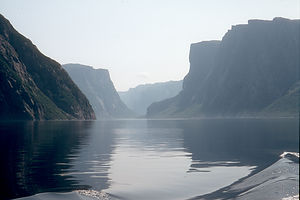 Western Brook Pond FjordThe park is divided into a north and south section, separated by Bonne Bay, which makes it a bit of a challenge to travel through. There is no loop drive through the park, but rather one must drive out and back to visit each section. This stop describes the northern portion of the park.
Western Brook Pond FjordThe park is divided into a north and south section, separated by Bonne Bay, which makes it a bit of a challenge to travel through. There is no loop drive through the park, but rather one must drive out and back to visit each section. This stop describes the northern portion of the park.
Route 430 (The Viking Trail) hugs the coast as it winds through the northern section of the park, with the spectacular Long Range Mountains to the east and the Gulf of St. Lawrence to the west.
An absolute must-do in this section of the park is the 2 ½ hour boat cruise up Western Brook Pond. This 10-mile long, landlocked fjord is sandwiched between giant cliffs with hanging gardens and waterfalls cascading down to the lake. The views are breathtaking. During July and August, there are three boat tours a day (10 am, 1 pm, and 4 pm). Since the tour is extremely popular, reservations are definitely recommended. For reservations, call the Ocean View Motel in Rocky Harbour (709-458-2730). Fares are about $23 per adult and $6 for children under 16. Getting to the boat requires about a 45-minute hike from the Western Brook Pond parking lot to the boat dock. The hike, which goes along a boardwalk across a bog where moose are frequently spotted, is worth doing even without the boat trip at the end.
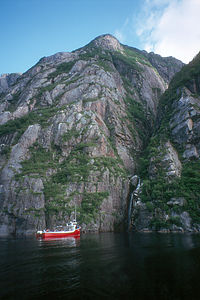 Boat cruise on Western Brook PondA little further north on 430 is a picnic area with wooden stairs leading down to a beach where the Western Brook Pond flows into the Gulf of St. Lawrence. Trout fishermen gather at the mouth of the river when the tide is flowing out. Theoretically, a fishing license isn’t required if you stay past the marker (towards the ocean side). Also, the water in the river is surprisingly warm enough to swim in.
Boat cruise on Western Brook PondA little further north on 430 is a picnic area with wooden stairs leading down to a beach where the Western Brook Pond flows into the Gulf of St. Lawrence. Trout fishermen gather at the mouth of the river when the tide is flowing out. Theoretically, a fishing license isn’t required if you stay past the marker (towards the ocean side). Also, the water in the river is surprisingly warm enough to swim in.
The next stop, just to the north of where Western Brook Pond meets the ocean, is Broom Point, the site of an isolated fishing settlement that has been restored by the national park service. The national park maintains a restored cabin and fish store where local interpreters explain what life was like for the Mudge family that lived and fished here from 1941 to 1975. The cabin is filled with some of the family’s original furniture and craftwork. In the fish store there are boats built by the Mudges, nets, traps, and other home-made fishing gear. The local interpreters provide information about what fishing was like in the past and the problems that fishermen are facing today.
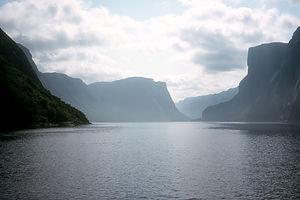 Western Brook Pond FjordContinuing north on 430, you exit the park briefly as you travel through St. Paul's village and Cow Head. Despite its apparent remoteness, Cowhead is home to the Gros Morne Theater Festival, in which the Theatre Newfoundland Labrador presents a series of 8 different plays during the summer at the Warehouse Theater. The village also has a small Community Museum which houses a rather odd and interesting assortment of artifacts, including an ax that was used to murder two people over 200 years ago.
Western Brook Pond FjordContinuing north on 430, you exit the park briefly as you travel through St. Paul's village and Cow Head. Despite its apparent remoteness, Cowhead is home to the Gros Morne Theater Festival, in which the Theatre Newfoundland Labrador presents a series of 8 different plays during the summer at the Warehouse Theater. The village also has a small Community Museum which houses a rather odd and interesting assortment of artifacts, including an ax that was used to murder two people over 200 years ago.
Leaving Cow Head, you reenter the northernmost piece of the park at Shallow Bay. Here there is a beautiful 3-mile sandy beach with surf, miles of hiking and biking trails, and a 50-site campground which is tucked away from the beach behind a line of tuckamore.
- ‹ previous
- 14 of 23
- next ›
Gros Morne National Park (Shallow Bay) location map
Javascript is required to view this map.
